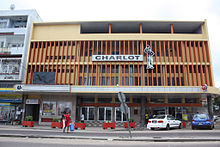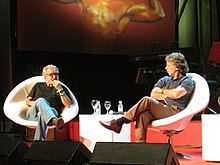Mozambican film
The Mozambican film comprises the national filmmaking of Mozambique .
history
prehistory
Parallel to the more recent history of Mozambique , the history of Mozambican cinema is also linked to the Portuguese colonial history and its centuries-old presence in the country. Mozambique did not appear at all in film history, due to the repression of the Portuguese colonial administration and the increasing censorship since the military coup of General Gomes da Costa in Portugal in 1926. An example of the dominance of official propaganda in the Portuguese film of the time is the film Chaimite by director Jorge Brum do Canto , which in 1953 depicted Gungunhana's defeat by the Portuguese colonial troops in Mozambique at the end of the 19th century.
In Mozambique, cinema developed more slowly than in Angola , which is also Portuguese , which has experienced stronger economic and population growth especially since the 1940s, and where there were local film productions under Portuguese colonial administration . This was reversed with independence in 1975, and Mozambique, unlike Angola, saw a clear turn to film.
From independence in 1975 to the end of the People's Republic in 1990

One of the first official acts of the socialist FRELIMO government under President Samora Machel after the country gained independence in 1975 was the establishment of the National Film Institute Instituto Nacional de Cinema (INC). Machel, who had invited well-meaning filmmakers into his sphere of influence during the liberation struggle, saw the film as an opportunity to spread his ideas in a country that was predominantly illiterate . Soon the film institute had 40 cinemas, mainly in the big cities, as well as mobile projectors from the Soviet Union , with the help of which films were shown in the marketplaces of the villages. Mozambique thus developed into the second largest film producer in southern Africa. The Mozambican Film Institute produced newsreels and documentaries with which the government pursued the creation of Marxist works in which form and content were to merge and become a tool for political education. The newsreels, called Kuxa Kanema , have been shown in mobile cinemas across the country. 395 newsreels, 119 short and 13 long documentaries were produced in the early years. The filmmakers were motivated not least by the manifesto “For a third cinema”, with which Pino Solanas and Octavio Getino spoke out in favor of a third cinema apart from both American-style entertainment cinema and European auteur films.
In 1976, for example, Ruy Guerra from Mozambique , a “father” of the new Brazilian film , followed the revolutionary government's call to return to his home country and take part in setting up a national film production. Famous directors like Jean-Luc Godard also came to Mozambique for support. However, the Mozambican civil war brought about stricter censorship and the death of Samora Machel in 1986 led to a decline in the importance of film production in Mozambique, as the media policy of his successors now focused on television. A large part of the early Mozambican film production today is threatened with decomposition due to the tropical and humid climate and the lack of means for proper storage.
Since 1990
A fire in the INC in 1991 destroyed a large part of the film archive and finally ended the work of the Mozambique Film Institute. The state practically stopped its support of the film in Mozambique.
However, the end of the People's Republic of Mozambique in 1990 and the subsequent change in Mozambique's economic policy made it possible for private production companies to emerge at the same time. Ebano Multimedia was the first private film production company in 1991, followed by six more. As a result, Mozambique was also able to establish itself as a production country for foreign films. A number of Portuguese film productions were shot here, including the award-winning Portuguese film Tabu - A Story of Love and Guilt (2012) and various films by José Carlos de Oliveiras . But especially films like Ali , the biography of Muhammad Ali (with Will Smith in the leading role), the German-American thriller Blood Diamond (2006), the international film adaptation of Mia Couto 's novel of the same name O Último Voo Do Flamingo (2010), or even Political thrillers like Die Dolmetscherin (2005) or Catch a Fire (2006) were shot in whole or in part in Mozambique and established it as an international film production country.
The history of Mozambican film, especially its committed documentary, is only slowly gaining the attention of film scholars.
Film festivals
The Mozambican film festival for the documentary Dockanema has been held in Maputo every year since 2006 (2011 in Berlin ).
Institutions
After the end of the INC ( Instituto Nacional de Cinema ), the INAC ( Instituto Nacional de Audiovisual e Cinema ) is coordinating the official film activities in the capital Maputo.
The Associação Moçambicana de Cineastas (AMOCINE), founded in 2003, is the association of directors in Mozambique. It promotes film art in the country with various initiatives. In 2010 AMOCINE was able to set up a film funding fund with the support of French development aid. 70% of its funds go to direct film funding for Mozambican productions, 20% are earmarked for supporting new, inexperienced filmmakers in the country, and 10% are earmarked for the distribution of the productions.
The initiative is also an attempt to compensate somewhat for the lack of a sales structure in the country. Up to now, films have been mostly simply archived and only partially and occasionally seen on television, such as the state TVM , without payments being made.
Directors
Ruy Guerra , who was born in 1931 in what is now Maputo, is probably the best-known director in Mozambican films . After a stopover in Portugal, he began his career in Brazil, at Cinema Novo in the early 1950s. Nevertheless, it was he who shot Mueda, Memoria e Massacre in 1980, Mozambique's first feature film after independence in 1975.
Other well-known Mozambique directors are Licínio Azevedo , Isabel Noronha , Victor Lopes and João Ribeiro .
Movies
→ See also: List of Mozambican films
Well-known Mozambican films are:
- O Gotejar da Luz (2002, director: Fernando Vendrell )
- The sleepwalking land (orig .: Terra Sonâmbula , 2007, director: Teresa Prata )
- O Último Voo do Flamingo (2010, director: João Ribeiro )
See also
Web links
- List of Mozambican films in the Internet Movie Database
- Blog about Cinema em Moçambique (port.)
- Mozambique Cinema: A Snapshot , 4-minute overview of the Mozambican film today, with three directors from the country and a comment by Volker Schlöndorff , recorded on YouTube
literature
- docs.pt # 7: Moçambique. Special issue of October 2008 of the Portuguese film magazine (with filmography of Mozambique 1941–2007 and an interview with Jean-Luc Godard from 1978 when he was a teacher at the INC in Mozambique)
Individual evidence
- ↑ http://www.arte.tv/de/580954,CmC=580966.html ( page no longer available , search in web archives ) Info: The link was automatically marked as defective. Please check the link according to the instructions and then remove this notice. Arte, accessed March 24, 2012.
- ↑ a b c Lost Continent: Cinema of Mozambique , article on the film history of Mozambique at www.mubi.com, accessed on December 26, 2014.
- ↑ taz article "Film archive in Mozambique"
- ↑ taz article "Film archive in Mozambique"
- ↑ taz article "Film archive in Mozambique"
- ↑ Article of March 25, 2009 on the publication of the comprehensive Mozambique special issue of the Portuguese film magazine docs.pt , blog of the TFM publishing house in Frankfurt , accessed on December 26, 2014.
- ↑ Article on Dockanema 2011 at www.berlinda.org
- ↑ a b Article on AMOCINE activities in the Mozambican film blog Cinema Mocambique , accessed on December 27, 2014.



